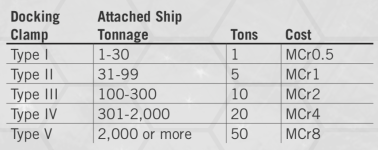Which was quite obviously designed for a LBB2 Small Ship Universe.
This is why in my most recent thinking,
external docking and towing has taken on such a prominence in what I do and post on these forums. If you can DOCK with another ship externally, you don't NEED to "pull it inside and close the doors" necessarily, so all of the "what shape is the volume of internal space?" questions get sidestepped (rather than needing a trash compactor to make stuff fit into deck plan images).
With respect to the Corsair "stowing" a 100 ton ship into its 160 ton cargo bay ... I figure that's a case of only needing to get the prize "partially" into the bay, rather than "entirely" into the bay (and shut the doors). So long as the prize can be "clamped in" and is unable to escape, that's all that's really needed. It would probably require leaving the (big) bay doors open to vacuum, but so long as the Corsair can "plug the prize" MOSTLY into the bay, that's enough. It's okay if some of the prize taken sticks out past the (open) doors.
Yet another example of why I'm of the opinion that
external docking and towing rules are needed for CT.



